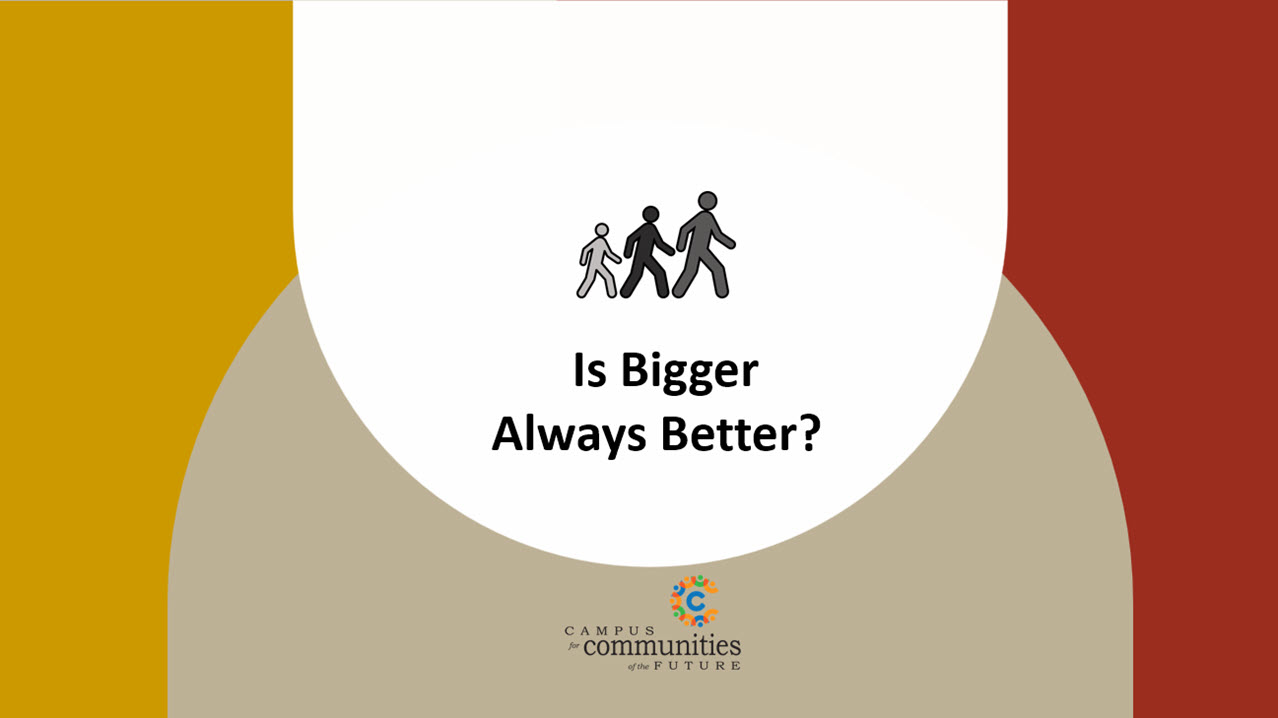Is Bigger Always Better?

It seems I’ve spent many years searching for a place that was a fit for someone like me with an entrepreneurial spirit and a deep commitment to making a difference.
My employment track record, while successful on some levels, could also be described as am eclectic history within corporations, social purpose organizations, education, government, and as the owner of several businesses.
Not finding a clear fit, I began investing my time and money to build and evolve the Campus for Communities of the Future as a social enterprise over 10 years ago.
Turns out I’ve joined a growing number of other social entrepreneurs, meaning those who are interested in starting a business for the greater social good and not just the pursuit of profit.
Typically, we are smaller in size and target the underlying root causes of issues, rather than prioritizing reaction to symptoms. Additionally, our efforts are often localized at the grassroots level, rather than the grasstops.
To ensure our social enterprises are a success, we’ve also had to be creative, resourceful, and nimble not only to generate revenue, but also to address the complexity of systems that often serve as barriers to innovation and transformative change.
Regretfully, one of our greatest challenges has been debunking the idea that ‘bigger is better’.
Until recently it has been accepted that while small, community-led organizations and enterprises can provide direct services, they weren’t as suited for facilitating transformative change.
Instead, it was accepted that systems change work belongs in the domain of large organizations with sizable budgets.
However, recent research has demonstrated smaller enterprises are better able to target the deeper root causes of the problems - rather than simply react to symptoms. In addition to being more nimble, they are closer to stakeholders and customers, and therefore better able to understand the complexity of the systems and how they can be influenced.
While it’s true larger organizations and companies may have more resources and could afford more risk and the potential of failure, they are instead often more risk-averse, and less likely to innovate. Choosing to hang on to what has worked in the past is more likely to be their modus operandi.
Regardless, the key to successful innovation and transformation ultimately requires leaders demonstrating an openness and a willingness to question existing ways of doing and being, an openness to exploring new possibilities, and a willingness to widen their existing tents by opening them to new players and collaborators who can contribute to solutions with their diverse voices and localized efforts.
Of course, it’s not an either/or situation as both smaller and larger organizations and enterprises are required to address today’s complex issues and opportunities.
It could also be we all need to consider Henry Ford’s advice who once said, ‘If you always do what you’ve always done, you’ll always get what you’ve always got”.
Bottom line? Our local and global communities need more than ‘what we’ve always got’ if we are to address today’s complex community and global issues. Policy, funding, and support for smaller enterprises might just be a good place to begin.
NOTE: Want to connect with other social entrepreneurs addressing what the UN has defined as our most pressing issues (the 17 Sustainable Development Goals or SDGS), consider becoming a member of Catalyst2030.
Next entry: Sparking Innovation: It Takes a Village
Previous entry: Why Are We Applying Rational Strategies to Irrational Situations?

 Brenda Herchmer is the owner of Grassroots Enterprises, a community development consulting company.
Brenda Herchmer is the owner of Grassroots Enterprises, a community development consulting company.